Posts Tagged ‘Frisco’
If Exide Goes Bankrupt, What Happens to the Lead-Filled Landfills of Frisco?
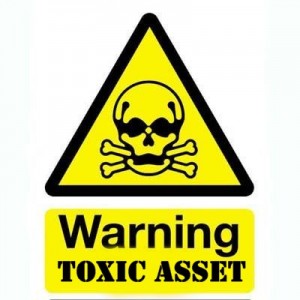 Last week the Exide battery company, owner of the now defunct Frisco lead smelter, hired a financial "restructuring" specialist firm by the name of Lazard, although the media coverage that followed the move suggested the more apt moniker could be Lazarus.
Last week the Exide battery company, owner of the now defunct Frisco lead smelter, hired a financial "restructuring" specialist firm by the name of Lazard, although the media coverage that followed the move suggested the more apt moniker could be Lazarus.
"Exide Technologies has been in the midst of a turnaround for awhile now and, like a car stuck in a snowbank, it hasn't been able to gain traction. Yesterday's price action on its stock suggests the market thinks it's going to end up in the ditch."
The news came on the same day the Los Angeles-based law firm of Glancy, Binkow & Goldberg said it would look into claims on behalf of Exide stockholders about possible violations of federal securities laws. Specifically, the firm’s investigation concerns allegations Exide issued misleading statements or failed to disclose material adverse facts concerning the company’s operations.
Nationwide, the company has been pulling back, selling off assets and closing plants. At last count, it had one operating smelter left in the US, and Exide just received noticed from the State of California that it will have to significantly reduce its pollution or it will be forced to close for causing a cancer hazard.
Meanwhile, the company is in the middle of a forced withdrawal from its Frisco smelter site, removing most buildings and surface structures, but leaving millions of pounds of lead contaminated smelter waste behind in a variety of landfills and dumps. It got some needed cash when the City of Frisco purchased surrounding acreage that was never the site of any production, but Exide is retaining ownership of the core smelter site – the very most toxic part.
Besides begging the question of whether this is the kind of company you want owning 100 toxic acres in the middle of your town – what happens if Exide doesn't own it? If the company goes bankrupt, who's responsible for insuring a thorough clean-up of the site, or doing anything else with it…ever?
You have to ask yourself if you were buying Exide's assets, would you really want a former smelter site with no smelter and lots of potential clean-up problems? On the other hand, the only path toward redevelopment of any kind hinges on the location of the land being in one of the region's hottest markets, so maybe a buyer that could invest in a clean-up could see some return from exploiting its proximity to everything else in Frisco.
If there's no buyers for Exide, the party of last resort is you the taxpayer via the EPA's Superfund Program. But that only guarantees you a spot on a waiting list. It could be left abandoned and toxic for decades after it's been officially listed.
You only have to look at Exide's former Dixie Smelter site in South Dallas to get an idea of what's in store for Frisco if the company is left to its own devices. Chain link fencing, warning signs, and a ring of groundwater monitoring wells surrounding a blank slate of land.
Which is to say that the City of Frisco has a spectacular self-interest in seeing that this entire smelter site gets the most protective, and most economically-desirable, clean-up that can be won. And so frustrating that the City signed over its rights to intervene in the formal closure permitting process.
If Frisco residents want a more pro-active role in insuring a proper and protective clean-up of a potential Superfund Site directly upstream from the City's proposed Grand Park, they're going to have to find a way for themselves or the City to act in self-defense on some other front besides the regulated closure process. Otherwise, they're just going to be helpless spectators to the last thing manufactured at the Exide site: a permanent toxic no-man's land.
Exide’s Crappy California Smelter Raising Cancer Risks
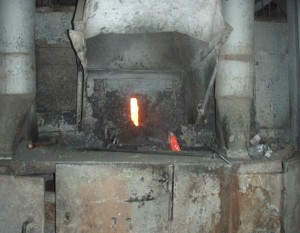 We've linked to the sad and horrible stories coming from ex-employees of the Frisco Exide Lead smelter that paint a disturbing picture of what went on when the public and regulators weren't looking. But this is Texas, where you practially have to have dead bodies piled up along your fenceline to get the state to do much about polluters and their pollution. What might happen if Exide were to have a rogue smelter in less-polluter-hospitable place, like, say, California?
We've linked to the sad and horrible stories coming from ex-employees of the Frisco Exide Lead smelter that paint a disturbing picture of what went on when the public and regulators weren't looking. But this is Texas, where you practially have to have dead bodies piled up along your fenceline to get the state to do much about polluters and their pollution. What might happen if Exide were to have a rogue smelter in less-polluter-hospitable place, like, say, California?
A battery recycling plant in Vernon is being told to reduce its emissions after recent tests showed it is posing a danger to as many as 110,000 people living in an area that extends from Boyle Heights to Maywood and Huntington Park.
The South Coast Air Quality Management District announced late Friday that Exide Technologies, one of the largest battery recyclers in the world, must also hold public meetings later this spring to inform residents that they face an increased cancer risk and outline steps being taken to reduce it.
Air district officials said Exide's most recent assessment showed a higher cancer risk affecting a larger number of residents than any other of the more than 450 regulated facilities in Southern California over the 25-year history of a program to monitor toxic air contaminants. The primary contaminant in this case was arsenic.
There has been "nothing close to this … never," said Sam Atwood, spokesman for the air district.In a statement, Exide officials said they planned to work with the district on emissions reductions "that we expect will meet or exceed" requirements. "Exide takes its environmental responsibilities seriously…."
Yes, so seriously, they've waited until they got caught to address these arsenic emissions. According to the most recent estimates, the company is posing a risk of 156 cancers per million population. The EPA standard is one in a million.
Under California's regulations, when cancer risk from a facility reaches 10 per million, public notification is required. When it hits 25, facilities must take steps to reduce their emissions. Exide was six times over that limit.
Since the 1987 Toxic Hot Spots program went into effect, only about 20 facilities in Southern California have ever reported risks that were greater than 25 in 1 million. More than 95% of the facilities the air district regulates have risks under 10 in 1 million.
California will force Exide to produce a "Risk Reduction Plan" within 6 months that will have to outline how the company will reduce its arsenic emissions. Failure to do so could result in $25,000 a day fines and a shut down order from a judge.
Meanwhile, Exide is doing everything possible in Frisco to make sure that city will have lead-waste landfills along Stewart Creek and near downtown forever – refusing to remove the hazardous waste that's been found in them in favor of "treating" it in place in town and saying it wants to "cap" all the dumps and landfills, even though many are on slopes and one is even partially in the flood plain.
Our bet is that Exide will choose to close its California smelter rather than install state-of-the-art controls, and then Frisco will have yet another community to commiserate with over the company's toxic leftovers.
Science Outpacing EPA Lead Contamination Standards
 People who don't know any better expect agencies that are charged with removing environmental threats to public health to be on top of the best and most recent science. However, because of the glacial pace of government environmental oversight, that's hardly ever true. It takes years, and sometimes decades for "safe standards" to be updated or created. When they are, they're sometimes instantly obsolete because a new generation of studies has shown harm at even lower levels of exposure. This is why impacted citizens have to have a DIY philosophy to seek out the most recent science themselves – you can't depend on government to have already incorporated it or be using it as a guide.
People who don't know any better expect agencies that are charged with removing environmental threats to public health to be on top of the best and most recent science. However, because of the glacial pace of government environmental oversight, that's hardly ever true. It takes years, and sometimes decades for "safe standards" to be updated or created. When they are, they're sometimes instantly obsolete because a new generation of studies has shown harm at even lower levels of exposure. This is why impacted citizens have to have a DIY philosophy to seek out the most recent science themselves – you can't depend on government to have already incorporated it or be using it as a guide.
A particularly depressing example is the way the US EPA is dealing with lead contamination and its soil and dust standards. The last time these were updated, Bill Clinton was President. There's been a lot of science produced on lead poisoning since then and all of it points to lower and lower levels of exposure causing harm. In fact, there's a consensus among researchers that there is NO safe level of exposure to lead. It's not that every exposure will harm you, it's that every exposure is capable of doing harm – especially to children.
There's also overwhelming public policy consensus that exposures to lead should be minimized as much as possible. Reducing exposure to lead is now linked, not just to better physical health, i.e. less cancer, liver disease, etc., but to higher IQs and test scores in schools, less anti-social behavior, and even less crime. In California, the lead standard for soil has been reduced to 80 parts per million, compared to the circa-2000 EPA standard still in place of 400 ppm.
Acting in recognition of these facts, for the first time in over 20 years the federal Centers for Disease Control revised its lead-in-blood standard for children in 2012, cutting in half the amount it said should trigger a response from parent and doctor. As a consequence, the EPA's own Children's Health Protection Advisory Committee sent a letter to then-Administrator Lisa Jackson calling for the agency's "immediate and urgent attention" to revise the nation's lead dust and soil standards because they had been based on the previous, now-obsolete CDC standard.
But in the latest installment of her year long award-winning series of articles on the topic, USA TODAY's Allison Young quotes EPA officials as saying they have no current plans to update those standards to reflect the new CDC lead in blood action level. This, despite studying the issue since 2009. What difference does it make?
In places like Frisco, Texas that experienced decades of lead contamination from a poorly and often illegally-operated lead smelter, it means the EPA will allow what it knows to be dangerous levels of lead to remain in soil and dust that otherwise would have to be cleaned-up.
This is Exhibit A why citizens cannot leave environmental protection to government agencies alone. This is why Frisco residents, organized by Frisco Unleaded, are trying to intervene directly in the closure and clean-up of the Exide lead smelter. If you leave it up to the state or EPA, you won't have the best science, or the most protective clean-up. You will have settled for whatever government standard was in place at the time, no matter how outdated or unsafe. If you're a parent in Frisco, that shouldn't be YOUR standard.
Shorter DMN: Citizens Demanding Frisco Smelter Clean-Up Hate Mexican Children
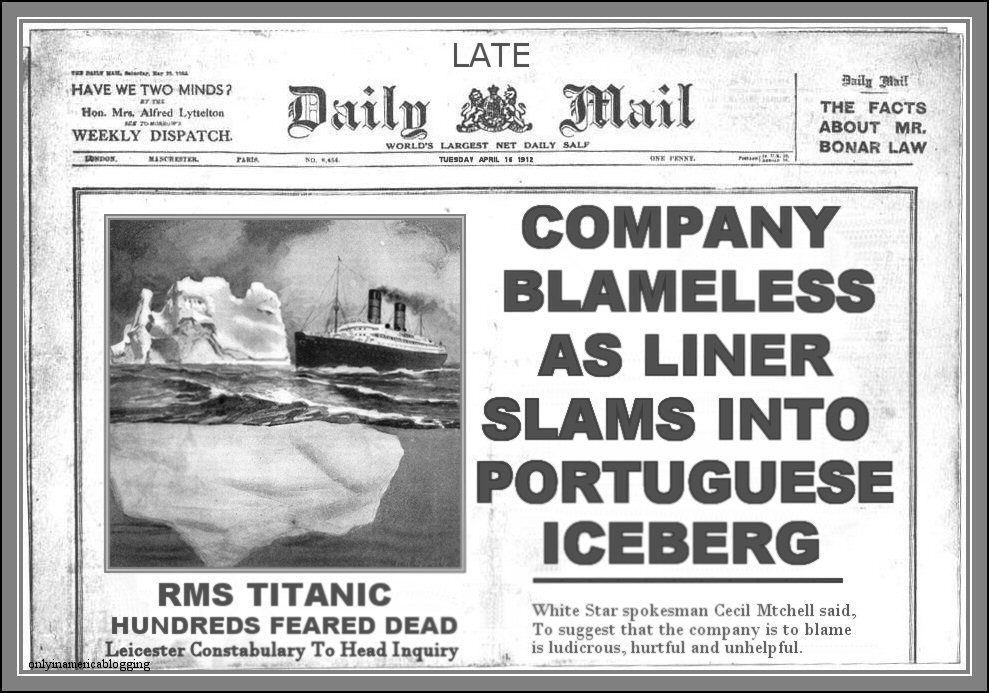 Because closing illegal smelters in your own backyard forces the corporations to build unsafe facilities in other places….or something like that.
Because closing illegal smelters in your own backyard forces the corporations to build unsafe facilities in other places….or something like that.
EPA Challenges State Clean-Up of Frisco Smelter Waste
 Despite denying that it was submitting comments on the state's plan for cleaning up the recently closed Exide lead smelter, the Environmental Protection Agency turned in a sometimes scathing assessment of Austin's proposal to allow the company to treat prohibited hazardous waste that still lies buried in its landfills in Frisco.
Despite denying that it was submitting comments on the state's plan for cleaning up the recently closed Exide lead smelter, the Environmental Protection Agency turned in a sometimes scathing assessment of Austin's proposal to allow the company to treat prohibited hazardous waste that still lies buried in its landfills in Frisco.
"The landfill is not permitted or constructed as a hazardous waste unit. Please clarify the regulatory/statutory provisions TCEQ is following that would allow for treatment of hazardous waste in the landfill," wrote EPA Associate Director Susan Spalding in a five-page letter sent to the Texas Com mission on Environmental Quality (TCEQ) on January 25th.
News of the Agency's comments comes on the eve of a public meeting scheduled by Exide for Wednesday night at the historic Frisco Depot to explain its clean-up operation.
Besides criticizing the on-site treatment of the hazardous waste, EPA also had a harsh review of the way Exide and TCEQ had identified areas of the current landfill with concentrated lead wastes that needed treatment, suggesting four times as much sampling as the company had proposed, and TCEQ had approved.
EPA also noted that a closed landfill in Frisco was already leaking hazardous levels of lead and selenium and suggested that the treatment method Exide is using in its current landfill was not going to be effective.
But in what may be a crushing blow to the company's plans to keep the wastes it generated for almost five decades buried in Frisco permanently, EPA stated that if the current landfill had been used for disposal after 2011 sampling to determine clean-up, which it almost certainly has,"This may require removal of all material" in the landfill.
Many of the problems cited by the Agency are the same ones citizens have been complaining about since Exide announced its unusual scheme to try to treat its illegal hazardous waste in place in its Frisco landfill, instead of digging it up and re-burying it in an official, licensed hazardous waste disposal site.
Exide does not have a permit to handle or dispose of hazardous waste. It's landfill is classified as a "non-hazardous waste" disposal site. The hazardous waste inside of it was discovered by inspectors several years ago.
Citizen groups have said Exide must apply for a full Resource Conservation and Recovery Act permit in order to deal with its prohibited wastes. EPA's letter seems to suggest that the Agency agrees.
Besides commenting on the landfill plans, EPA's letter also seeks changes in the dust controls guiding the smelter clean-up, and the public release of information about the clean-up.
Copies of the EPA letter can be downloaded from the Frisco Unleaded website here.
"We're very appreciative that EPA changed its mind and decided to comment on the ridiculous plans by Exide and TCEQ to use the same treatment method on this hazardous waste that failed to work the first time," said Colette McCadden, Chair of Frisco Unleaded, the citizens group who successfully campaigned to close the old smelter last year.
"We hope the EPA continues to provide needed oversight to what Exide and the state are doing – or not doing."
Other groups were more cautious.
"It's a pleasant surprise to see EPA comment so bluntly about the more absurd parts of the proposed Exide clean-up," said Jim Schermbeck of Downwinders at Risk. "My hope is that this is only the beginning of a new level of review for Exide by the Agency in light of the USA Today's "Ghost Factory" series chronicling what happens when it's not paying such attention. Only time will tell."
They’re Not Asking Your Permission
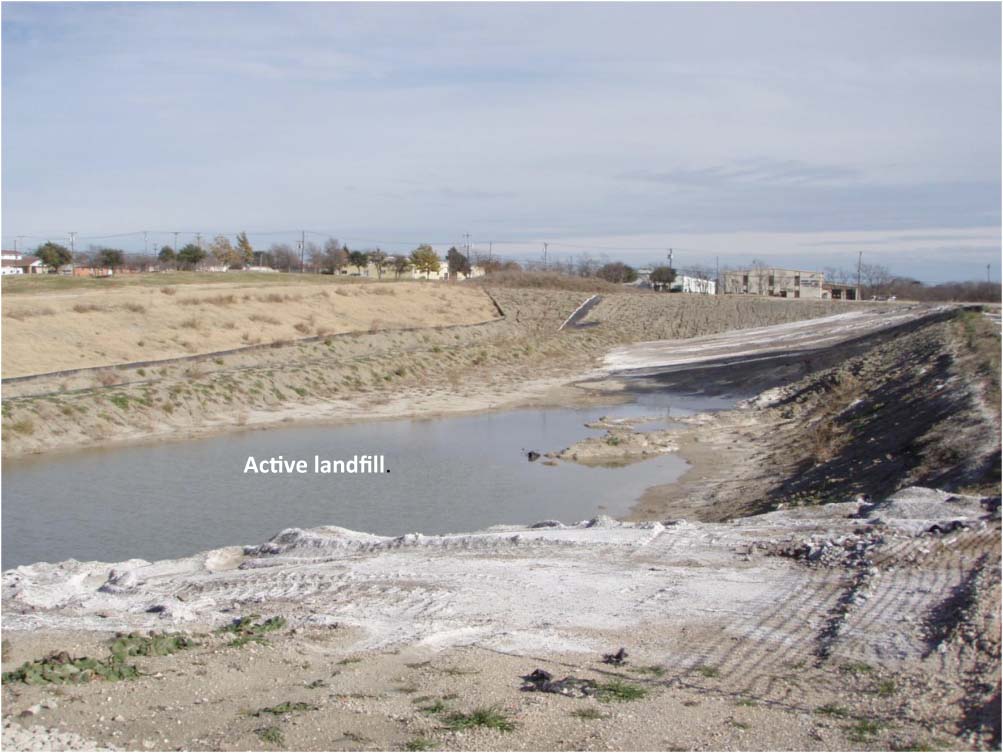 Exide and the State are planning Frisco's future without it's residents.
Exide and the State are planning Frisco's future without it's residents.
This Wednesday night may be one of the few times they can object in person.
Plans are proceeding for Exide to leave landfills full of its lead smelter waste in Frisco….forever
Landfills of lead on the edge of downtown that will pose a constant public health threat and economic dead zone
Landfills of lead along the banks of Stewart Creek as it flows downstream into the City's new "Grand Park"
Join us in saying no to their lead-filled future of Frisco.
Exide's Public Meeting on their lead smelter "Clean-up"
THIS WEDNESDAY NIGHT
7:00 pm
Frisco Depot
6499 Paige Street
(in the Historic District by Babe's)
Whether Frisco residents like it or not, Exide and the State of Texas are deciding to let millions of pounds of lead waste stay buried in Frisco forever – and the current City Council isn't trying to stop them.
While the city bought the less-contaminated outer ring of the Exide lead smelter, the most toxic part of the facility is still owned by Exide.
The City of Frisco has said that it won't interfere in the way the company and state decide to handle the tons of lead waste buried in this area, which stretches from Stewart Creek to the edge of downtown.
Exide, the state, and this city council are all deciding that it's easier just to leave lead contamination permanently buried in place in the middle of Frisco instead of moving it away from people and flowing water.
If citizens don't show up and fight back against these plans, Frisco residents will be dealing with lead contamination issues for decades – just like other communities that didn't have their lead smelter waste cleaned-up completely either.
A former Exide smelter site still sits abandoned in Dallas, some two decades after it closed, surrounded by monitoring wells and a chain link fence. We can't let that happen here.
Many residents sent e-mails to Exide last week saying they wanted a complete clean-up of its lead waste in Frisco. Now they need to come in person with the same message.
Frisco residents have to stand up for their home and community. Nobody at Exide or in government is.
Was Lead Contamination the Major Cause of 20th Century American Crime?
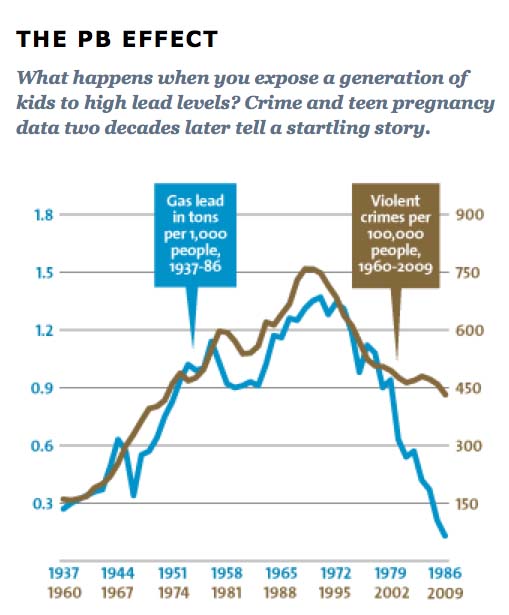 That's the hypothesis that Kevin Drum makes in the latest issue of Mother Jones, and he has a lot of evidence to back it up.
That's the hypothesis that Kevin Drum makes in the latest issue of Mother Jones, and he has a lot of evidence to back it up.
For years, scientists have known about the link between lead exposure in children and decreasing IQ levels. More recently, researchers have discovered more subtle effects in terms of anti-social behavior and AHHD diagnosis. Now, modern toxicology is to the point where most leading researchers say there is no level of lead a child can be exposed to that doesn't have the potential to effect his or her personality.
What if you were to use what we know now about the effects of lead contamination on young minds and playback the last 70 years of American history?
The biggest source of lead in the postwar era, it turns out, wasn't paint. It was leaded gasoline. And if you chart the rise and fall of atmospheric lead caused by the rise and fall of leaded gasoline consumption, you get a pretty simple upside-down U: Lead emissions from tailpipes rose steadily from the early '40s through the early '70s, nearly quadrupling over that period. Then, as unleaded gasoline began to replace leaded gasoline, emissions plummeted.
Gasoline lead may explain as much as 90 percent of the rise and fall of violent crime over the past half century.Intriguingly, violent crime rates followed the same upside-down U pattern. The only thing different was the time period: Crime rates rose dramatically in the '60s through the '80s, and then began dropping steadily starting in the early '90s. The two curves looked eerily identical, but were offset by about 20 years.
So Nevin dove in further, digging up detailed data on lead emissions and crime rates to see if the similarity of the curves was as good as it seemed. It turned out to be even better: In a 2000 paper (PDF) he concluded that if you add a lag time of 23 years, lead emissions from automobiles explain 90 percent of the variation in violent crime in America. Toddlers who ingested high levels of lead in the '40s and '50s really were more likely to become violent criminals in the '60s, '70s, and '80s.
Dr. Howard Mielke of Tulane, who's analyzed the blood lead data collected from Frisco and found the samples higher than the state average, makes an appearance in Drum's article because of a large new study overlaying neighborhood lead exposure to neighborhood crime in six American cities. They match up precisely.
Read the short version of the article here. Here's an interview with Dr. Mielke.
No one knew a lead additive in gasoline would produce such an impact. Because we didn't do the toxicology. Lead was introduced in gasoline in the 1920's when the modern industrial age was just hitting its stride. Now there are some 80,000 chemicals in the marketplace, only a handful of which have been tested thoroughly, including lead, because we're still not doing the toxicology BEFORE the chemical is used in widespread commerce.
Cancer. Birth Defects. Endocrine Disruptors. Why is it so inconceivable to some that the thousands of untested chemicals coursing through the veins of our economy can't have unintended consequences just like leaded gasoline, on their own or in combination with each other? What new epidemics are we instigating even now?
Good Friday: Exide Smelter Closing Today
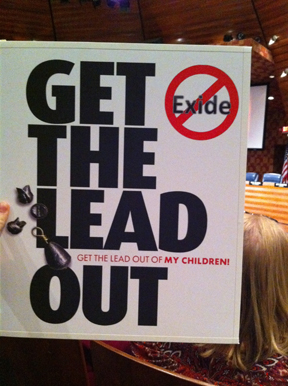 Sometimes, all it takes is the slightest push of an index finger, or a focused exhaling of breath.
Sometimes, all it takes is the slightest push of an index finger, or a focused exhaling of breath.
Sometimes the house of cards is so precarious, so unstable, that any challenge, no matter how slight, can send the established structure to the ground.
A year ago a small, newly-formed citizens group that had just staged its first action was struggling to convince the City of Frisco to quit supporting co-existence with an outlaw lead smelter and instead kick it out of town.
Today, that smelter will stop operating.
Community activism rarely pays off as quickly or as spectacularly as it has with the curious case of the Exide lead smelter. But when it does, it's reason to pause and give thanks and remind ourselves that such things are still possible.
Because truth be told, this historic effort was directed by a group of Frisco residents that was never larger than 10 people strong. Please just think about that. Less than a dozen people challenging their local status quo are responsible for this huge victory for public health.
Downwinders' often tells its supporters that, like the Woody Allen quote about life, 90% of social change is about just showing up. The system so often goes completely unchallenged, that you'd often be surprised what happens when you just show up and start asking embarrassing questions. When you start poking at the house of cards.
As their campaign proceeded, this small group of committed people attracted the support of hundreds, and then thousands of their fellow residents. They forced the city to see the contradiction between the continued operation of a circa-1960's smelter and the reality of 2012 Frisco. They held up a mirror and re-framed the relationship between smelter and town. And the contradiction was so great, so at odds with the new perception of Frisco, that the established political support the smelter had enjoyed in town for decades dried up. Young couples with kids concerned about a lead smelter they never heard of before outnumbered Good Ol Boys in City Hall and the Chamber of Commerce. The old establishment was undone by the very demographics of change they'd unleashed a decade or so earlier.
There is still much work to do. A half-century of contamination blankets the smelter site, as well as an undetermined number of off-site "hotspots." Exide wants to leave a permanent landfill behind in the middle of Central Frisco, while the City is breezing along with plans to turn a piece of land right across the street from the smelter site into the city's largest park. Downwinders will be helping citizens monitor the cleaning-up of the smelter site for at least the next two years.
But as of today there is no more lead pollution coming out of the Exide smokestacks. No more daily fallout of poison. No more new layers of lead being laid down in the topsoil of Frisco. That is a pretty remarkable thing considering where we were 365 days ago.
So raise your glasses tonight to the hardy folks of Frisco Unleaded and the improbability of the impossible happening in record time. Here's to Colette McCadden, Henrik Ax, Shiby Matthew, Matt Vonderahe, Jeannette Sandin, Meghan Green, and Eileen Canavan, all residents who decided they would stick their neck out and start showing up and asking questions, much to the consternation of the Powers That Be. May they all have Frisco parks, and schools, and streets named after them.
It's not always this easy, but the fact that it was this time should give us hope about the power of pushing back.
